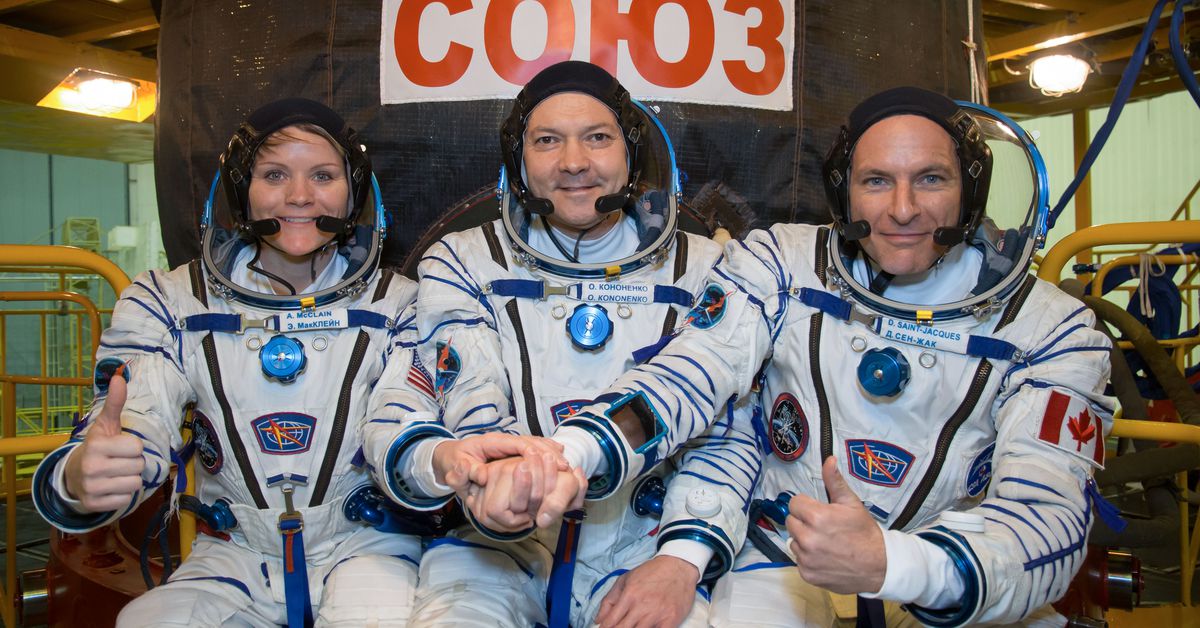
Early Monday morning, a crew of three astronauts are set to launch to the International Space Station on a Russian Soyuz rocket — the first time people will ride on the Soyuz after the vehicle broke apart mid-flight in October with two passengers on board. Following an investigation, Russia claims to have identified and fixed the problem that led to the failure, deeming the rocket ready to carry people again.
The Soyuz has launched successfully four times since the accident. However, it has only launched once in the same configuration as the Soyuz that failed, a version of the rocket known as the Soyuz FG. That launch in November was a success, and put a Russian cargo capsule called Progress into orbit. The flight paved the way for Monday’s mission, when the Soyuz FG will prove if it is safe for human spaceflight again.
Prior to the failure, the Soyuz FG had a 100 percent success rating since it first launched in 2001. But on October 11th, the vehicle suffered a catastrophic anomaly with two riders on board — NASA astronaut Nick Hague and Russian cosmonaut Aleksey Ovchinin. Just two and a half minutes after the Soyuz took off from Kazakhstan, the rocket broke apart 31 miles up. The failure immediately prompted the vehicle’s emergency abort system, causing the capsule carrying the crew to separate from the rocket. They capsule then performed a ballistic descent — when the vehicle falls to Earth at a much steeper angle than normal. After pulling 6.7 Gs, or 6.7 times the pull of Earth’s gravity, Hague and Ovchinin both landed safely back on Earth.
Footage of the launch clearly showed that something went wrong during the first stage separation, when the rocket sheds parts of hardware during flight. Normally, the Soyuz has four boosters surrounding its main core that separate in a cross-like configuration during the flight. Instead, one of the four boosters made contact with the middle core, causing the Soyuz to break apart.
Russia’s state space corporation, Roscosmos, has since traced the failure to a deformed sensor responsible for signaling the stages to separate. The sensor was apparently damaged during assembly, and Roscosmos found that two additional Soyuz rockets might have had the same defect. However, the corporation says that the problem has since been fixed and should not affect future missions.
Since Hague and Ovchinin did not make it to the ISS as planned, Roscosmos moved up today’s flight to ensure that the station didn’t have a deficit of crew members for long. Originally, this flight — which will carry NASA astronaut Anne McClain, Canadian astronaut David Saint-Jacques, and Russian cosmonaut Oleg Kononenko — was supposed to launch on December 20th, in order to join Hague and Ovchinin. That way, they’d replace the current three people on board the ISS — NASA astronaut Serena Auñón-Chancellor, German astronaut Alexander Gerst, and Russian cosmonaut Sergey Prokopyev — who were slated to leave mid-December. But this way, the new crew will arrive well before the current crew leaves.
And that means if all goes well with this flight, NASA won’t have to entertain the possibility of an empty space station. The current crew on the ISS arrived at the ISS in early June in a Soyuz capsule. However, the Soyuz has a limited lifetime in orbit, lasting only about 200 days in space before needing to come back down. If a new crew doesn’t make it to the space station before the end of December, then either an empty Soyuz would need to be launched to the ISS to extend the current’s crew time — or the crew would need to come home and leave the station empty.
For now, those scenarios are not in danger of becoming reality just yet. And McClain, who will be making her first trip to space, says she “has confidence” about riding on the Soyuz right after the failure, telling the Houston Chronicle that “no one would give the green light to fly,” unless the problem had been solved.
The Soyuz is slated for takeoff at 6:31AM ET out of Baikonur Cosmodrome in Kazakhstan. NASA plans to provide live coverage of the mission starting at 5:30AM ET. Once the Soyuz reaches orbit, it is slated to dock with the ISS at 12:35PM ET.
This article is from The Verge









